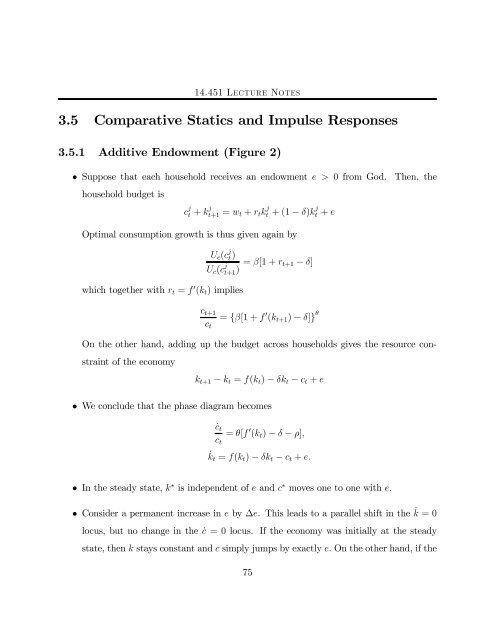14.451 Lecture Notes Economic Growth
14.451 Lecture Notes Economic Growth
14.451 Lecture Notes Economic Growth
Create successful ePaper yourself
Turn your PDF publications into a flip-book with our unique Google optimized e-Paper software.
<strong>14.451</strong> <strong>Lecture</strong> <strong>Notes</strong><br />
3.5 Comparative Statics and Impulse Responses<br />
3.5.1 Additive Endowment (Figure 2)<br />
• Suppose that each household receives an endowment e > 0 from God. Then, the<br />
household budget is<br />
c j<br />
t + k j<br />
t+1 = wt + rtk j<br />
t +(1− δ)k j<br />
t + e<br />
Optimal consumption growth is thus given again by<br />
which together with rt = f 0 (kt) implies<br />
Uc(c j<br />
t)<br />
Uc(c j<br />
t+1) = β[1 + rt+1 − δ]<br />
ct+1<br />
ct<br />
= {β[1 + f 0 (kt+1) − δ]} θ<br />
On the other hand, adding up the budget across households gives the resource con-<br />
straint of the economy<br />
kt+1 − kt = f(kt) − δkt − ct + e<br />
• We conclude that the phase diagram becomes<br />
˙ct<br />
ct<br />
= θ[f 0 (kt) − δ − ρ],<br />
˙kt = f(kt) − δkt − ct + e.<br />
• In the steady state, k ∗ is independent of e and c ∗ moves one to one with e.<br />
• Consider a permanent increase in e by ∆e. This leads to a parallel shift in the ˙ k =0<br />
locus, but no change in the ˙c =0locus. If the economy was initially at the steady<br />
state, then k stays constant and c simply jumps by exactly e. On the other hand, if the<br />
75

















